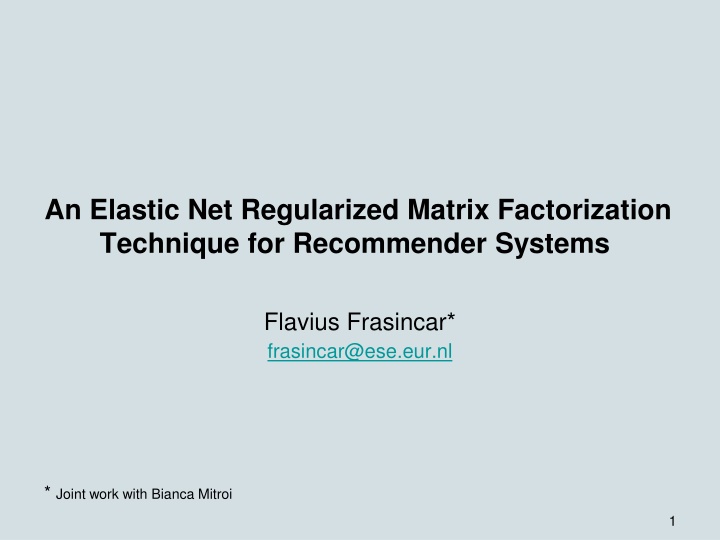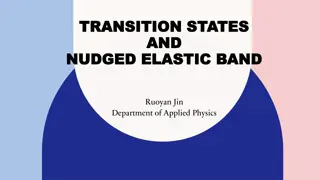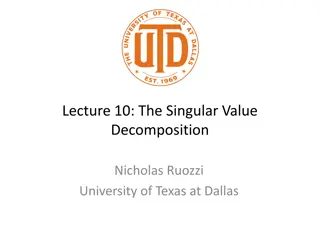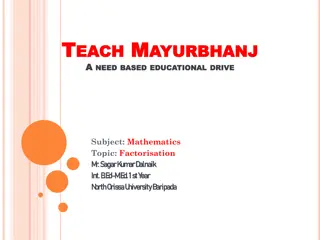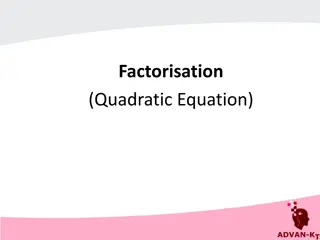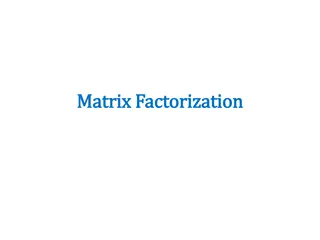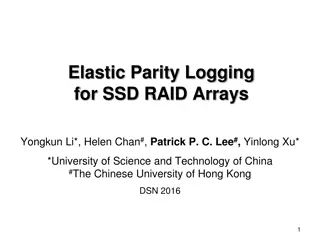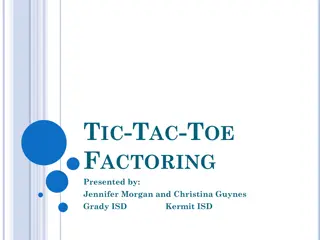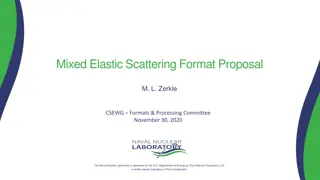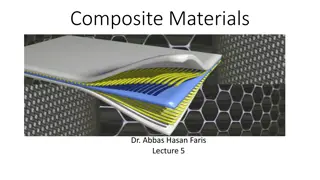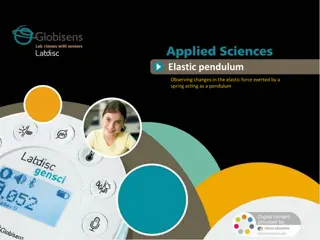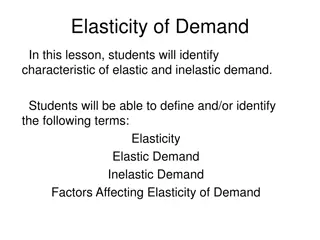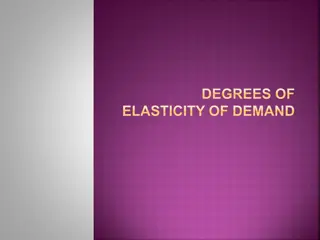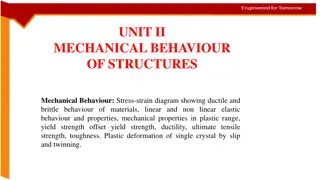Elastic Net Regularized Matrix Factorization for Recommender Systems
This research paper presents an elastic net regularized matrix factorization technique for recommender systems, focusing on reducing the dimensionality of the problem and utilizing features to describe item characteristics and user preferences. The approach combines existing algorithms and applies elastic net regularization to answer questions related to user preferences and item factors in a movie dataset.
Download Presentation

Please find below an Image/Link to download the presentation.
The content on the website is provided AS IS for your information and personal use only. It may not be sold, licensed, or shared on other websites without obtaining consent from the author.If you encounter any issues during the download, it is possible that the publisher has removed the file from their server.
You are allowed to download the files provided on this website for personal or commercial use, subject to the condition that they are used lawfully. All files are the property of their respective owners.
The content on the website is provided AS IS for your information and personal use only. It may not be sold, licensed, or shared on other websites without obtaining consent from the author.
E N D
Presentation Transcript
An Elastic Net Regularized Matrix Factorization Technique for Recommender Systems Flavius Frasincar* frasincar@ese.eur.nl * Joint work with Bianca Mitroi 1
Contents Motivation Related Work Methodology Evaluation Conclusion 2
Motivation Growing amount of online data Difficult to find the items of interest Recommender Systems: predict the user preference for a certain item Recommender System Types: Collaborative Filtering: Memory-Based Approaches: Item-Based or User-Based Model-Based Approaches: Matrix Factorization [our focus here] Content-Based Filtering Hybrid: Mix of different recommender system types 3
Motivation Matrix Factorization: Reduces the dimensionality of the problem Uses features that describe item characteristics and user preferences Application Domain: Movies Main Ideas: Generalize two existing algorithms proposed by Koren, Bell, and Volinksy (2009) [KBV] and Gogna and Majumdar (2014) [GM], respectively Make use of the elastic net regularization by Zou and Hastie (2005) Answer questions in relation to users and items on a movie dataset: Does a user have preferences for all item factors? Is an item characterized by all factors? 4
Related Work KBV Approach Ridge regularization on the user factor loadings and item factor loadings The shrinking parameters for users and items are equal Two optimization methods: Alternating Least Squares (ALS): scales well for large and sparse datasets (using parallelism) Stochastic Gradient Descent (SGD): easy-to-implement and faster than ALS [our focus here] 5
Related Wok GM Approach Ridge regularization on the user factor loadings Assumption 1: A user has preferences for all movie factors Lasso regularization on the item factor loadings Assumption 2: A movie is not characterized by all factors (assumes that factors represent genres) The shrinking parameters are not equal Optimization method: Majorization-Minimization (MM): applicable to non-differentiable functions but slower than SGD 6
Related Work Elastic Net Compromise between the ridge and lasso regularizations (linear combination of ?2 Performs variable grouping as ridge and variable selection as lasso Our Hypotheses Hypothesis 1 (different than GM): A user has no preferences for certain movie factors The factor mainstream crowd-pleaser could not characterize users that have a strong preference for suspense over predictability Hypothesis 2 (like GM): A movie is not characterized by all factors (but factors do not necessarily represent genres) Factors are critically-acclaimed and mainstream crowd pleaser (Koren et al., 2009) are not genre-related (pertain to all genres) 2and ?1 penalties) 7
Methodology Matrix Factorization Our methodology is called Elastic Net Matrix Factorization (ENetMF) Matrix Factorization ? is the user-item rating matrix ? is the set of users ? is the set of items ? is the set of factors ?? ? is the vector for user ? ?? ? is the vector for item ? ??T?? = ??? is an estimate of user ? rating for item ? (unknown) ??T?? ??? is an approximation of user ? rating for item ? (known) 8
Matrix Factorization Regularization We need to estimate: ?? for all users ? = 1, ,|?| ?? for all items ? = 1, ,|?| In total there are ? ( ? + ? ) coeficients to be estimated ? large enough to capture the characteristics of the rating matrix ? small enough to avoid overfitting Example: ? = 8 (determined by cross-validation) ? = 943 and ? = 1682 We need to estimate 8 943 + 1682 = 21,000 coefficients Large number of coefficients leads to overfitting (overestimates the effect of some coefficients, i.e., produces large coefficients) Solution: Regularization (penalizes the magnitude of coefficients) 9
Matrix Factorization Ridge 2 penalty (convex) ?2 Non-convex loss function (product of ?? ? and ??): 2+ ?1?? 2 ??? 2+ ?2?? 2 2 min ??,?? ??? ?? ?,? ? where: ? is the set of pairs ?,? for which ??? is known ?1 and ?2 are positive constants (shrinkage parameters determined by cross-validation) ?1?? 2 The penalty term shrinks the values of ?? and ?? (the higher ?1 and ?2, the smaller ?? and ??) Same coefficients for correlated variables (variable grouping) 2 is the penalty term 2+ ?2?? 2 10
Matrix Factorization Lasso ?1 penalty (convex) Non-convex loss function: 2+ ?1?? 1+ ?2?? 1 ??? min ??,?? ??? ?? ?,? ? where: ? is the set of pairs ?,? for which ??? is known ?1 and ?2 are positive constants (shrinkage parameters determined by cross-validation) ?? and ?? can be 0 (variable selection) Higher values of ?1 and ?2 produce a greater number of 0 values for ?? and ?? 11
Matrix Factorization Elastic Net Linear combination of ?2 Non-convex loss function: 2 and ?1 penalties (convex) 2+ ?1?? 2 ??? 2+ ?2?? 2 2 min ??,?? ??? ?? ?,? ? +?1?? 1+ ?2?? 1 where: ? is the set of pairs ?,? for which ??? is known ?1, ?2, ?1, and ?2 are positive constants (shrinkage parameters determined by cross-validation) Variable grouping Variable selection 12
Methodology Related Work KBV Approach: ?1= ?2 [ridge for users and items] ?1= ?2= 0 [no lasso] GM Approach: ?1= 0 [ridge for users] ?2= 0 [lasso for items] ENetMF Approach tests two hypotheses: Hypothesis 1 (different than GM):A user has no preferences for certain movie factors Hypothesis 2 (like GM): A movie is not characterized by all factors (but factors do not necessarily represent genres) 13
Methodology Estimation Stochastic Gradient Descent (SGD) [fast method]: performs several times this procedure (til error converges) Loops over all the ratings ??? in the training set: Loop over all factors ?: Compute current error ???=??? ???= ??? ?? Update ??? (in the opposite direction of the gradient of the loss function) Compute new error ??? (considering also the updated ???) Update ??? (in the opposite direction of the gradient of the loss function) The SGD update rule: ? ? ????(?,???) where: ? are the coefficients to be estimated ? is the loss function ? is the learning rate (a positive constant determined by cross-validation) ??? 14
Methodology Estimation The soft-thresholding operator: ? y+ ? ?,? = sign ? ? ?,if ? > 0 and ? > ? ? + ?,if ? < 0 and ? > ? 0,if ? ? = The update rules: ??? ? ???+ ? ?????? ?1???,??1 2 ??? ? ???+ ? ?????? ?2???,??2 2 15
Methodology Estimation Six hyperparameters optimized using cross-validation: |?|: the number of matrix factorization factors ?1 and ?1: the elastic net hyperparameters for user factors ?2 and ?2: the elastic net hyperparameters for item factors ?: the SGD learning rate Hyperparameter constraints: |?|: positive integer number that cannot be 0 ?1, ?1, ?2, and ?2: positive real numbers that can be 0 ?: positive real number that cannot be 0 16
Evaluation Dataset MovieLens 100K dataset: 100,000 ratings (1-5) 943 users 1,682 movies Ratings statistics: On average 100 movie ratings per user Users rated from 20 movies to 737 movies On average each movie received 60 ratings: The most popular movie received 600 ratings Average rating is 3.53 and variance is 1.27 The mode of the ratings is 4 (34% of the ratings take this value) ? has 943 1,682 = 1,586,126 entries from which 100,000 are given (sparse matrix) 17
Evaluation Experimental Setup Training dataset: 90% of the dataset Test dataset: 10% of the dataset Hyperparameters tuning: 10 fold cross-validation on the training dataset Decision based on the lowest average (10 folds) of the mean absolute error (MAE) Build a model based on the best hyperparameters on the training dataset and report results on the test dataset For fair comparison we have implemented: KBV GM ENetMF (our approach) 18
Evaluation Experimental Setup Mean Absolute Error (MAE) ?,? ????? ??? ?? 1 10???1+ ???2+ + ???10 ????= ??? = where: ?? is the of pairs ?,? for which the user-item rating is known in fold ? = 9,000 (? = 1, ,10) and ?? =90,000 10 ??? ??? {0,1,2,3,4} 19
Evaluation Experimental Setup Prediction Error Spread (PES) ??,?=??,? ?? 1 10 ??= ?1,0+ ?2,0+ + ?10,0 where: ??,?is the proportion of errors of size ? (? = 0,...,4) that occur in the validation fold ? (? = 1, ,10) ??,? is the number of errors of size ? that occur in the validation fold ? ?? = 9000 is the size of the validation fold ? Runtime Number of seconds from the beginning of the algorithm, throughout the matrix factorization until predictions are made 20
Evaluation Hyperparameters Setup Optimal values after grid search using 10-fold cross validation on the training dataset: ? = 0.001 (from 0.0001 to 0.005 with step 0.0001) |?| = 8 (from 2 to 20 with step 1) ?1, ?2, ?1, and ?2 set to 0.25 for the determination of ? and ? and later optimized per algorithm (values from 0 to 0.5 with step 0.1) Software and hardware configuration: Programming language: PHP Intel Xeon W3680 3.33GHz six core CPU 12 GB RAM 64-bit Windows 10 Code available at: https://github.com/ibmitroi/ENetMF https://github.com/ibmitroi/ENetMF 21
Evaluation Hyperparameters Setup ? = 0.001 |?| = 8 With increasing |?|, the runtime increases at a high rate 22
Evaluation Results ENetMF: (?1,?2,?1,?2) = (0.3,0.0,0.0,0.0) KBV: (?1,?2,?1,?2) = (0.2,0.2,?.?,?.?) GM: (?1,?2,?1,?2) = (0.2,?.?,?.?,0.1) (bold values by construction) Hypothesis 1 (different than GM):A user has no preferences for certain movie factors Rejected as in ENetMF there is no selection of factors for users (?1= 0, i.e., no lasso) Hypothesis 2 (like GM): A movie is not characterized by all factors Rejected as in ENetMF there is no selection of factors for movies (?2= 0, i.e., no lasso) 23
Evaluation Results MAE: ENetMF: ?.???? KBV: 0.9543 GM: 0.9523 PES (percentage where prediction error is 0,1, or 2): ENetMF: ??.??% KBV: 94.39% GM: 94.41% Runtime ENetMF: 62.27s (?1, ?1, ?2, and ?2) KBV: ??.??s s(?1= ?2) GM: 61.80s (?1 and ?2) 24
Evaluation Results ?1 is the only parameter common to all models Sensitivity analysis around optimal ?1for each model ( 0.05) All models are stable for ?1 ENetMF 25 GM KBV
Conclusion We have proposed the Elastic Net Matrix Factorization (ENetMF), which generalizes previous approaches based on ridge or lasso penalties Using the MovieLens 100K dataset: ENetMF is better than KBV and GM in terms of Mean Absolute Error and Prediction Error Spread (w.r.t. maximum two points from real ratings) Remark 1: Users have preferences for all movie factors Remark 2: Movies are characterized by all movie factors Future work: Use a genetic algorithm to optimize together |?|,?1,?2,?1,?2,and ? Try a larger values for |?| (more factors might make the grouping and selection effects of elastic nets visible) 26
References Anupriya Gogna and Angshul Majumdar. Distributed elastic net regularized blind compressive sensing for recommender system design. 20th International Conference on Management of Data (COMAD 2014), pages 29-37. Computer Society of India, 2014. Yehuda Koren, Robert Bell, and Chris Volinsky. Matrix factorization techniques for recommender systems. IEEE Computer Society, 42(8):30-37, 2009. Hui Zou and Trevor Hastie. Regularization and variable selection via the elastic net. Journal of the Royal Statistical Society: Series B (Statistical Methodology), 67(2):301-320, 2005. 27
